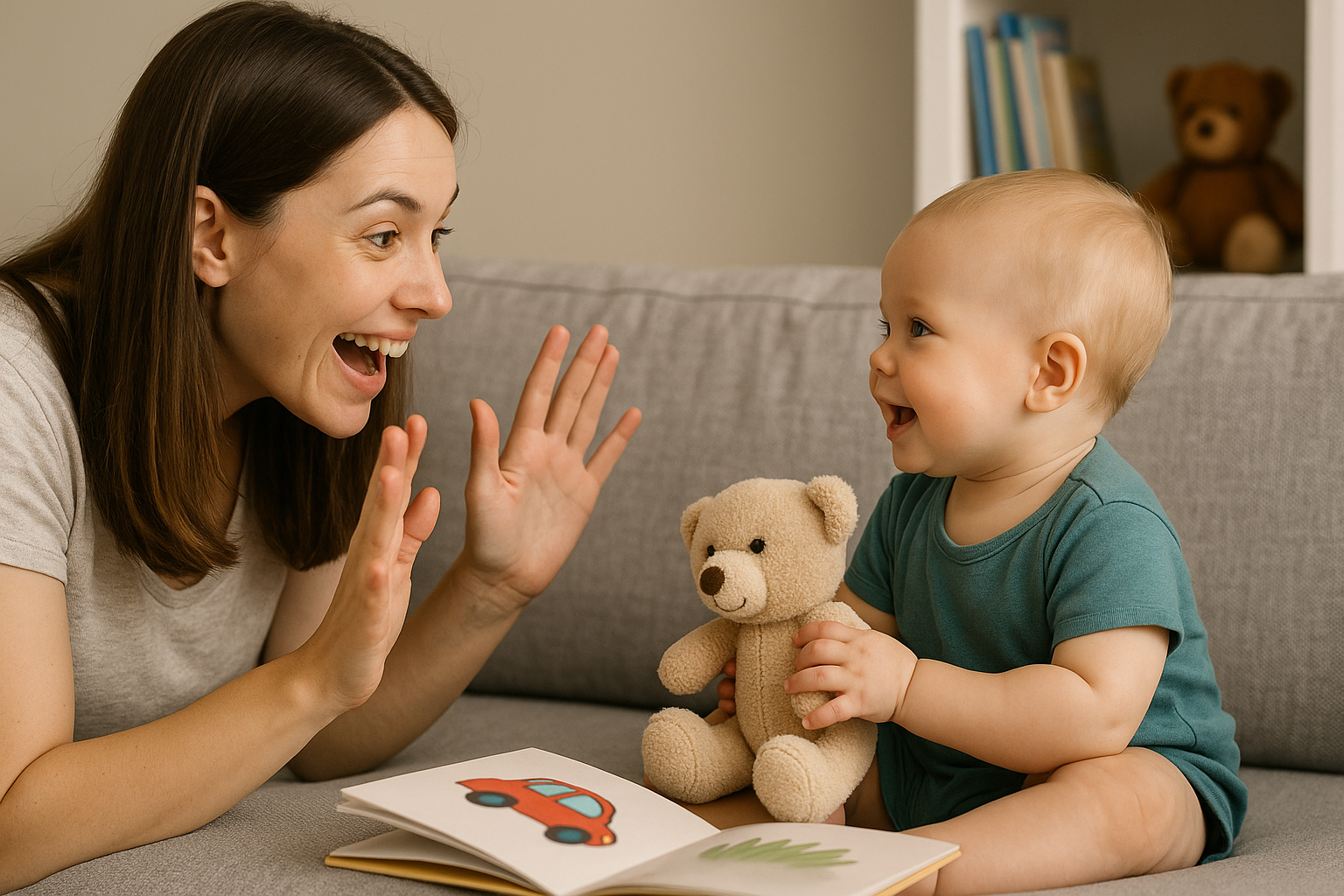Language development is one of the most exciting milestones of early childhood. While it might seem like babies learn to speak naturally, there’s actually a lot you can do to support and stimulate that growth—especially through play.
Talking, listening, and interacting with your baby during everyday moments lays the foundation for strong communication skills that will serve them for life.
Here’s how you can encourage your baby’s language development through fun, simple activities at home.
Why Play Is Essential for Language Learning
Babies learn best through play. It’s how they explore the world, make connections, and practice new skills. Play stimulates the brain, encourages social interaction, and gives context to the words they hear.
When you play with your baby, you’re not just entertaining them—you’re teaching them how to communicate.
Start Early—From Day One
You don’t have to wait until your baby can talk to start supporting their language development.
From the Newborn Stage:
- Talk frequently: narrate what you’re doing, even diaper changes or making coffee
- Use a warm tone: babies respond to emotional expression
- Make eye contact while speaking to build connection
- Imitate sounds they make, even coos or gurgles
These early interactions teach your baby that sounds have meaning and that communication is a two-way process.
Use “Parentese” to Your Advantage
“Parentese” is the high-pitched, exaggerated, sing-song voice many adults naturally use when speaking to babies. And it’s backed by science!
Research shows that:
- Babies prefer this speech style
- It helps them recognize word boundaries
- It holds their attention longer
Use short, clear sentences, repeat words, and slow your speech. For example:
“Look at the dog! Woof, woof! That’s a big dog!”
Describe Everything Around You
Your baby is constantly absorbing language—even before they understand words.
Make your everyday routines into learning opportunities:
- “Now we’re putting on your socks. One sock… two socks!”
- “Let’s wash your hands. Splash, splash!”
- “This is your bottle. Drink, drink!”
Labeling objects, actions, and emotions helps babies connect words to the world around them.
Play Face-to-Face Games
Eye contact and facial expressions are essential for communication. Choose games that bring you face-to-face and encourage vocal responses.
Try:
- Peekaboo: teaches turn-taking and object permanence
- Pat-a-cake: introduces rhythm and hand coordination
- Singing songs: enhances memory and word repetition
- Silly sounds: blowing raspberries, animal noises, etc.
Pause frequently and wait for your baby’s response—whether a smile, a coo, or a look. That’s the beginning of conversation!
Read Every Day (Even to Newborns)
Reading is one of the most powerful tools for language development.
Benefits of Reading Aloud:
- Builds vocabulary
- Improves listening skills
- Strengthens parent-child bonding
- Exposes baby to sentence structure and emotion
Start with board books or cloth books. Choose books with:
- Bright, simple pictures
- Rhymes or repetition
- Touch-and-feel textures
Make reading a daily routine—at nap time, bedtime, or anytime.
Respond to Baby’s Sounds and Gestures
When your baby babbles or gestures, respond like they’re speaking real words.
For example:
- Baby: “Ba ba!”
- You: “Yes, that’s your ball! Let’s play with the ball.”
This teaches your baby that their voice matters—and that communication gets results.
You’re building confidence, curiosity, and motivation to keep trying.
Use Toys That Encourage Communication
Simple toys can be powerful tools for language learning.
Great Choices Include:
- Soft dolls or animals: practice names and emotions
- Blocks: describe colors, shapes, stacking
- Balls: use words like roll, throw, bounce
- Mirrors: babies love looking at faces and hearing names
- Puppets: act out little stories or conversations
Avoid overly noisy or flashy toys that don’t require interaction. You want toys that invite back-and-forth engagement.
Repeat, Repeat, Repeat
Repetition helps your baby remember words and understand how they’re used. Don’t worry about sounding like a broken record—it’s exactly what they need!
For example:
- “This is your spoon. Here’s your spoon. Let’s use the spoon!”
- “You’re sad. It’s okay to feel sad. Mama’s here.”
- “Dog. Dog. Look at the dog!”
Hearing the same words in different situations helps your baby grasp their meaning.
Celebrate Every Attempt
Whether it’s a gurgle, a pointing finger, or their first real word, respond enthusiastically!
- Clap and smile
- Repeat their sound with excitement
- Add on a real word: “Ba ba!” – “Bottle! Yes!”
Positive reinforcement keeps your baby motivated to keep exploring language.
Your Voice Is Your Baby’s Favorite Toy
You don’t need fancy programs or expensive toys to help your baby develop language. What matters most is you—your voice, your time, your love.
Every time you sing, talk, read, or laugh with your baby, you’re wiring their brain for communication. You’re showing them that language is powerful, joyful, and full of connection.
Keep talking. Keep playing. You’re giving your baby the words that will shape their world.
